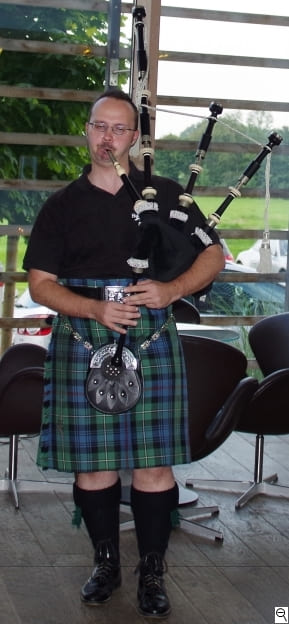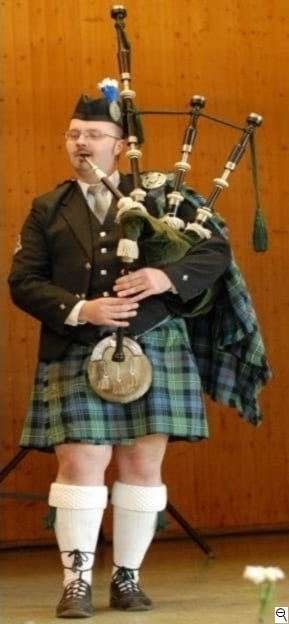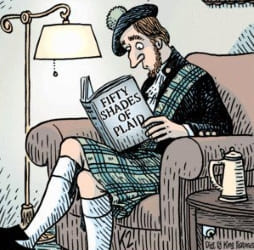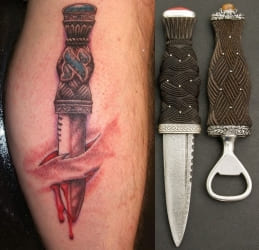OUTFITS:
...clothes make the man...
 |
1. Black-Dress - "the modern" |
|
The Black-dress is our standard outfit, mainly in black colour. We use it on informal events like city festivals, birthdays, ... The outfit is intended to be modern, close to the audience, casual but still uniform and to a certain degree classy. In rarely occasions we use also "coloured" kilts, which means a not unitary tartan over all band members. Main characteristic is: black poloshirt with bandlogo and black socks. |
|
 |
2. Argyll-Dress - "the traditional" |
|
The Argyll-dress is a traditional, formal outfit for special and official occasions like weddings. Main characteristics are: white shirt, tie, Argyll-west and -jacket, Glengarry and white socks. In some occasions we use also a so called Flyplaid, which is in contrast to the military Fullplaid or Piper's Plaid fitted only on the left shoulder and hangs down more casually. Alternatively we also use the Argyll-dress with black shirt and socks if desired. |
You can see our different outfits on our event pictures to get an idea how the look like in the group.
Following is a small glossary for the most important parts of our outfits:

Kilt:
The kilt is a special kind of wraparound - knee-length, weaved from wool, folded on the backside - which is weared by men in scotland. Traditionally it's reserved for men, women wear so called kilted skirts - kiltrelated skirts which can be a little bit longer or shorter than men's kilts. Between 1746 and 1782 it was prohibited to wear a kilt as result of the battle of culloden. After this they became again "fashionable" just in the 19th century.
With the kiltpin - a kind of decorated safety pin - the open end of the wraparound is fixated. Usually not both layers are fixated as the weight of the kilt pin is mostly enough to secure the upper layer from fluttering around.
Sporran:
A sporran is part of the traditional scottish kilt outfit and replaces mostly the trouser pockets. Often made from leather, sometimes it's ornamented with fur or other decoration elements. It has a chain or leather band to wear it over the inguinal region - while in some cases it's moved to the side of the hip.
One has to differ casual sporrans (simple leather bags with less ornamentation), formal sporrans (more ornaments, usually also with fur) and horsehair sporrans (with long horsehairs - especially for military regimental uniforms).
Waistbelt:
A broad waistbelt made from leather which is worn - like a trousers' belt - on the kilt. The ornamented belt buckle has a similar design as the sporran, sgian dubh and kiltpin.

Sgian dubh:
The sgian dubh is a traditional part of kilt accessories. As part of the "disarming act", is was prohibited for scotsmen to wear weapons, so they had to hide them - which is an alternative interpretation of the mostly black handle of the verbal translation "knife black". Traditionally as sign of confidence among friends, the sgian dubh is worn visible in the right sock. Nowadays it's part of the folklore knifes.
Ghillie Brogues:
The traditional ghillie brogues go down to scottish and irish shephards who made little bores into their shoes to dump water from the swamps and marshes. At the same time the bores support a faster drying of the shoes. As traditional shoe it has a quite complex cording above the ankle.
Argyll-west and -jacket:
The Argyll-outfit is one of the typical official types of dresses ("evening dress") and has mainly a five-button-west and a jacket above the shirt and tie. The name goes down to the estate Argyll on the westcoast of scotland. An alternative evening dress can be for example the Prince-Charlie-Dress, which has west and jacket differently cut and is worn with a bow tie instead of a normal tie.
Glengarry:
The Glengarry Bonnet is a hat (originally introduced 1794 as characteristic of the scottish highland regiment Glengarry Fencibles) which was spread among its international military use in different professional guilds and organisations. The common german name "Schiffchen" goes down to its ship-like shape.
Plaid:
The plaid can be seen as a kind of extension of the kilt. It has the same tartan as the kilt and is worn folded (fullplaid / piper's plaid) or loose (flyplaid) on the left shoulder and fixed on the jacket with a brooch in similar design to the other accessories. Flyplaids are noticeable smaller (1 to 1.5 yards edge length) as fullplaids with 3.5x1.5 yards.


